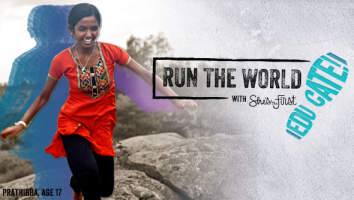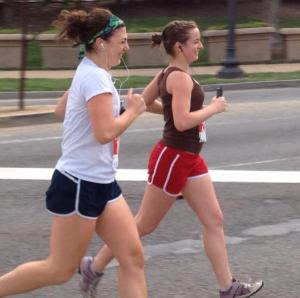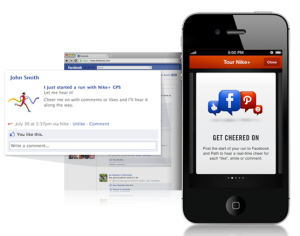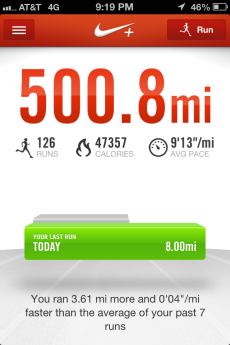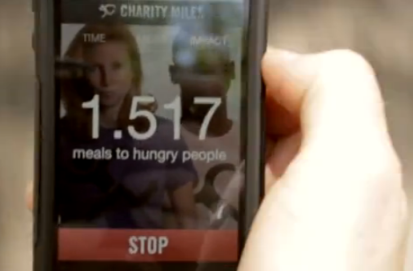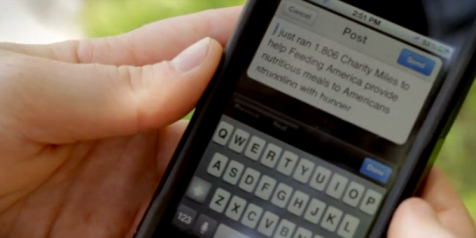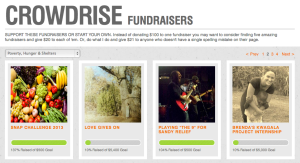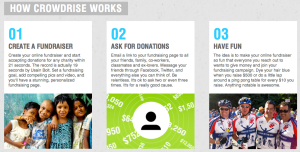Every morning, I wake up to an e-mail from Mike Allen, one of the nation’s most “in-the-know” political reporters. Described as being “the most powerful” or “important journalist in the capital,” Mike Allen is the man behind Playbook, the free daily e-mail tip-sheet that reaches the inboxes of the nation’s movers, shakers and policymakers (Leibovich, 2010).
Playbook is packed with the morning’s headlines, spottings around the Hill, birthday shout outs, personal anecdotes and the day’s leading political headlines. During my past semester in Washington D.C., I looked as forward to reading Playbook as I did to enjoying my morning cup of coffee!
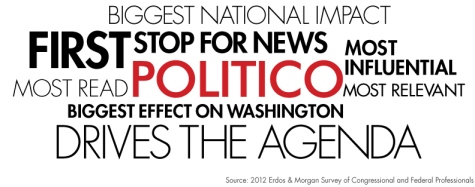
Playbook was my first introduction to POLITICO, a “one-stop shop for the fastest, most in-depth coverage of the White House, Congress, politics and policy” (“Facts and Logos”). In an age when the 24-hour news cycle adds extra pressure to be the first source of breaking news, Playbook gives POLITICO a winning edge. In Washington, POLITICO is everywhere – in print, online, on mobile devices. POLITICO’s influence spans editorials, blogs, newsletters, videos, events, books, television and radio appearances, and debates.
For the past several months, I have benefitted greatly from POLITICO’s free online news coverage, and am certainly not alone in this. In fact, POLITICO’s online readers now total five to seven million (“Facts and Logos”). As you’ll see in the graphic below, its reader base is spread evenly among political parties, which indicates its nonpartisan coverage. For most of these readers, access to POLITICO is free. POLITICO’s free tip-sheets (like Playbook) are especially popular among readers, with each one having at least 8,500 subscribers (Warzel, 2012).
POLITICO also offers free coverage on the following banner topics:
- Elections – offers polls and commentary on upcoming and current elections
- POLITICO 44 – curates information on President Obama’s time in office
- Congress – provides updates on Congressional members and legislation
- Blogs – analysis on media, domestic politics, politico “celebs,” SCOTUS, etc.
- Opinion – POLITICO’s daily weigh-in on the nation’s political conversations
- Policy – highlights health care, finance, the environment, defense, technology, infrastructure & transportation
- Media and Outreach – publishes videos and photos, as well as hosts events
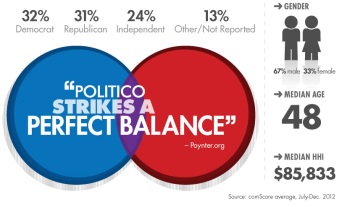
PROfessional POLITICO
Last year, POLITICO launched POLITICO Pro, a premium news platform that requires a subscriber log-in. POLITICO Pro focuses on the “defense, energy, finance, health care, tax, technology and transportation” sectors (“Other Brands”). As a regular POLITICO reader, I was thrilled to find out that my employer purchased a company-wide subscription to the news service.
Once I created a login and profile for POLITICO Pro account, I was asked to select the specific sectors I was interested in, as well as how often I wanted to receive e-mail notification. The image below highlights the customization features offered to Pro subscribers. To start, I selected health care and now receive e-mail updates throughout the day regarding breaking news and legislative developments in our nation’s health policy. Pro subscribers also have the option of receiving morning and afternoon briefings, a calendar of events that would interest politicos and invites to subscriber-only events.

Photo via LaFrance, Nieman Journalism Lab
Pricing Model
While POLITICO relies on advertising revenue to fuel its web and print presence, POLITICO Pro uses a freemium and advertiser model. POLITICO Pro integrates paid subscribers with paid advertisers.

Photo via Pompeo, Capital New York
POLITICO prides itself in its ability to specifically target America’s leading policymakers, making it an ideal ad space for lobbying causes. For online advertisers, POLITCO offers “homepage takeovers, interstitial units, footer bars and policy channels sponsorship” (“Platforms”). The print edition is also highly profitable for POLITICO. Thanks to “deep-pocketed lobbyists [who] pay dearly to have ads appear in the free newspaper,” POLITICO’s print edition has even been called “a cash cow for the digital brand” (Pompeo, 2012). Unique sponsorship opportunities are also open on print, e-mail, video and mobile platforms.
For example, regularly interspersed into Playbook’s body copy is a message from a paid advertiser. This morning’s e-mail, shown in the image below, offered this reminder:
** A message about BP’s commitment to America: Over the last five years, BP has been America’s largest energy investor. Each year, we invest an average of $11 billion here and produce nearly enough oil, gas and renewables to light the entire country. In the process, we support almost 250,000 American jobs. Learn more about our commitment to America at facebook.com/BPAmerica. **
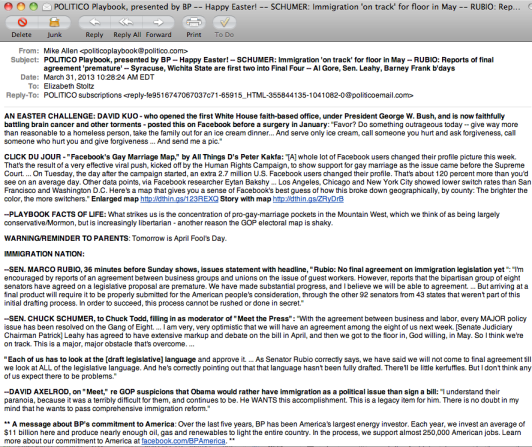
Specifically for POLITICO Pro subscribers, access to this segmented, breaking information doesn’t come cheaply. Just five licenses will run a subscribing company or organization $8,500 (Warzel, 2012). Individual licenses cost $3,295 (LaFrance, 2012). This price difference indicates that POLITICO Pro also engages in bundling. More specifically, the more licenses an organization takes on, the cheaper the subscription price. This is an example of aggregation and trade-up bundling, incentivizing a customer to purchase more product, though it doesn’t cost POLITICO anything more to distribute its already created content.
To date, 1,000 organizations have invested in the value that POLITICO Pro provides, which equates to approximately 7,000 readers (Ellis, 2013). Recognizing that more organizations join than individuals, POLITICO Pro invests its energies in recruiting group memberships, primarily from Washington-based governmental organizations (LaFrance, 2012).
Effectiveness
Based on POLITICO’s high readership, rave reviews, the amount of time each month the average reader devotes to POLITICO, renowned coverage and excellent customer service, I feel that its strategy is an extremely effective one. In an age where information is expected to be freely acquired, POLITICO delivers, while also compelling people to pay for specialized content. Even though POLITICO Pro’s readership is limited to approximately 7,000 individuals (compared to POLITICO’s online readership of 6MM each month), it has been deemed an extremely successful web venture with plans to grow.
POLITICO Pro’s success is also indicated by its 96% renewal rate among subscribers (Warzel, 2012). Commenting on this high number, Roy Schwartz, Politico’s chief revenue officer, said “A number like this is unheard of in this space” (as qtd. in Warzel, 2012). As its readership increases, POLITICO Pro says it will look to increase the sectors it will cover. Furthermore, the numbers below indicate that POLITICO’s free strategy is one that continues to hook readers and influence the conversation in Washington.

What I appreciate most about POLITICO Pro’s updates is that they are succinct. Though the emails are frequent, the content consists of no more than a few sentences. During the workday, these emails provide a perfect way to have the most pressing news at my fingertips, while not getting distracted in a sea of tweets or online articles. POLITICO Pro goes out of its way to deliver rapid updates in a user-friendly way, and is continuing to develop its communications in a way that’s most relevant to those dipping in and out of meetings on the Hill, on K Street, in the Eisenhower Executive Building and in the White House. As evidenced by the quotes below, POLITICO is celebrated among influential media outlets. I believe it will continue to serve as a valid and trusted resource for politicians and politicos alike.

On a more sentimental level, Playbook does an excellent job of fostering a sense of community among its readers. Though they may be spread across the nation and range from a college student in Ithaca to President Obama’s right-hand advisor, Mike Allen strings his daily tip sheet together with jokes, anecdotes about family parties and congratulations to a recently engaged Hill staffers amidst the nation’s hard-hitting headlines. It was my introduction to and continued happiness with Playbook that fuels my support of POLITICO and POLITICO PRO. The fact that so many other millions across the nation feel the same indicates the success of this online news source.
Works Cited
Ellis, Justin. “Politico Pro Grows to 1,000 Subscribing Orgs, Moves into Print »
Nieman Journalism Lab.” Nieman Journalism Lab. N.p., 12 Mar. 2013. Web. 01 Apr. 2013. <http://www.niemanlab.org/2013/03/politico-pro-grows-to-1000-subscribing-orgs-moves-into-print/>.
“Facts and Logos.” Politico. POLITICO. Web. 31 Mar 2013.
<http://www.politico.com/about/facts-and-logos>.
LaFrance, Adrienne. “Politico Pro, One Year In: A Premium Pricetag, a Tight Focus,
and a Business Success » Nieman Journalism Lab.” Nieman Journalism Lab. N.p., 17 Apr. 2012. Web. 01 Apr. 2013. <http://www.niemanlab.org/2012/04/politico-pro-one-year-in-a-premium-pricetag-a-tight-focus-and-a-business-success/>.
Leibovich, Mark. “The Man the White House Wakes Up To.” New York Times 21 Apr
2010, n. pag. Print. <http://www.nytimes.com/2010/04/25/magazine/25allen-t.html?pagewanted=all>.
“Other Brands.” Politico. POLITICO. Web. 31 Mar 2013.
<http://www.politico.com/about/other-brands>.
“Platforms.” Politico. POLITICO. Web. 31 Mar 2013.
<http://www.politico.com/about/advertising/platforms/online>.
Pompeo, Joe. “What Politico’s Beltway Cash Cow, Its Print Edition, Wants from New York (and What It Doesn’t).” Capital New York. N.p., 17 Jan. 2012. Web. 01 Apr. 2013. <http://www.capitalnewyork.com/article/media/2012/01/5053479/what-politicos-beltway-cash-cow-its-print-edition-wants-new-york-and-w>.
Warzel, Charlie. “Politico Is Making Money With Subscriptions.” AdWeek. N.p., 21
June 2012. Web. 31 Mar. 2013. <http://www.adweek.com/news/technology/politico-making-money-subscriptions-141293>.

